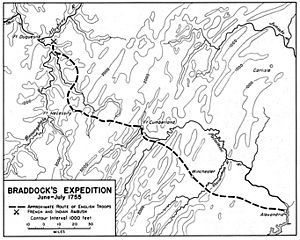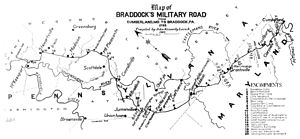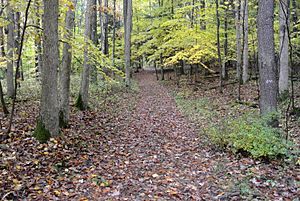Braddock Expedition facts for kids
Quick facts for kids Braddock Expedition |
|||||||
|---|---|---|---|---|---|---|---|
| Part of the French and Indian War | |||||||
 Route of the Braddock Expedition |
|||||||
|
|||||||
| Belligerents | |||||||
| Native Americans | |||||||
| Commanders and leaders | |||||||
| Strength | |||||||
| 637 natives, 108 French marines 146 Canadian militia |
2,100 regular and provincials 10 cannon |
||||||
| Casualties and losses | |||||||
| 30 killed 57 wounded |
500+ killed 450+ wounded |
||||||
|
Pennsylvania Historical Marker
|
|||||||
| Designated: | November 3, 1961 | ||||||
The Braddock Expedition was a big military trip by the British army in the summer of 1755. It was led by General Edward Braddock. Their goal was to capture Fort Duquesne, a French fort located where Pittsburgh is today. This happened during the French and Indian War (1754-1763).
Sadly for the British, the expedition failed. They faced a major defeat at the Battle of the Monongahela on July 9, 1755. General Braddock himself died during this effort. This loss was a huge setback for the British early in the war.
Contents
Why the Expedition Happened
The Braddock Expedition was part of a larger British plan. They wanted to attack the French in North America from several directions. General Braddock was the main commander for this big push. He led about 2,100 soldiers into the Ohio Country.
His army included 1,400 regular British soldiers. There were also 700 soldiers from the British American colonies. Braddock thought it would be easy to capture Fort Duquesne. He then planned to take more French forts, aiming for Fort Niagara.
A young George Washington, only 23 years old, joined the expedition. He knew the area well and helped General Braddock. Braddock also tried to get Native American tribes to join him. However, most tribes, like the Delaware, stayed neutral. They wanted to see who would win before choosing a side.
Building Braddock's Road
The expedition started from Fort Cumberland in Maryland on May 29, 1755. Moving such a large army was a huge challenge. They had to carry heavy cannons and supplies through thick forests. The journey was about 110 miles (177 km) across the Allegheny Mountains.
Benjamin Franklin helped a lot by getting wagons and supplies. Famous future Americans like Daniel Boone and Daniel Morgan were also part of this journey. The army moved very slowly. Braddock wanted to build a good road as they went. This road, called Braddock's Road, was important for bringing supplies later.
Sometimes, they only moved about 2 miles (3 km) a day. To go faster, Braddock split his army. A "flying column" of 1,300 men went ahead with him. The rest, 800 men with supplies, followed far behind. On their way, they passed the ruins of Fort Necessity. This was where the French had defeated Washington the year before. Small groups of French and Native American fighters often attacked Braddock's men during the march.
Meanwhile, at Fort Duquesne, the French had a smaller force. They had about 250 French soldiers and Canadian militia. Around 640 Native American allies were camped nearby. The French commander, Claude-Pierre Pécaudy de Contrecœur, knew he couldn't stop Braddock's cannons. So, he decided to attack Braddock's army first. He planned an ambush as they crossed the Monongahela River.
The Battle of the Monongahela
On July 9, 1755, Braddock's troops crossed the Monongahela River. They faced no resistance at first. An advance group of 300 soldiers, led by Lieutenant Colonel Thomas Gage, moved ahead. George Washington tried to warn Braddock about fighting in the woods. He knew the French and Native Americans fought differently. But Braddock ignored his advice.
Suddenly, Gage's group met the French and Native American forces. They were rushing to the river, late for their planned ambush. The French commander, Daniel Liénard de Beaujeu, was killed early in the fight. Some French Canadians ran back to the fort. But another French officer, Jean-Daniel Dumas, quickly rallied the rest.
This battle became known as the Battle of the Monongahela. It is also called the Battle of the Wilderness or Braddock's Defeat. It was not a planned ambush, but a "meeting engagement." This means two forces clash unexpectedly. The French and Native Americans reacted quickly. This made many British soldiers think they had been ambushed.
After some fighting, Gage's advance group fell back. They crashed into Braddock's main army, causing chaos. The Canadian militia and Native Americans surrounded them. They fired from the woods, hidden from view. The British soldiers tried to form lines, but it was hard in the forest. They became easy targets.
The British used cannons, but they were not effective in the thick woods. Some colonial soldiers fought from cover. But sometimes, British regulars mistook them for the enemy and fired at them.
After hours of intense fighting, General Braddock was shot off his horse. The British resistance collapsed. Colonel Washington, even without an official command, helped keep some order. He formed a group to protect the retreating soldiers. This earned him the nickname "Hero of the Monongahela."
By sunset, the surviving British forces were running back down the road they had built. Braddock died from his wounds on July 13. He was buried near Fort Necessity.
The battle was a disaster for the British. Out of about 1,300 men, 456 were killed and 422 were wounded. Many officers were targeted. Out of 86 officers, 26 died and 37 were wounded. Only 4 of the 50 women with the army survived. The French and their Native American allies had far fewer losses.
Colonel Dunbar took command of the remaining British forces. He ordered supplies and cannons to be destroyed. This was to prevent them from falling into French hands. Even after the defeat, the British still outnumbered their opponents. But the French and Native Americans did not chase them. They were busy looting and celebrating their victory.
Images for kids
See also
 In Spanish: Expedición Braddock para niños
In Spanish: Expedición Braddock para niños






